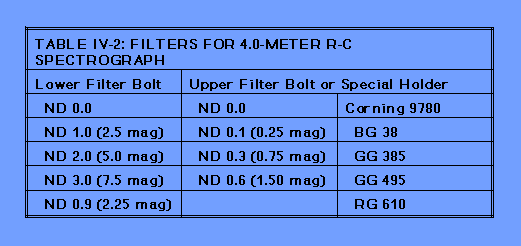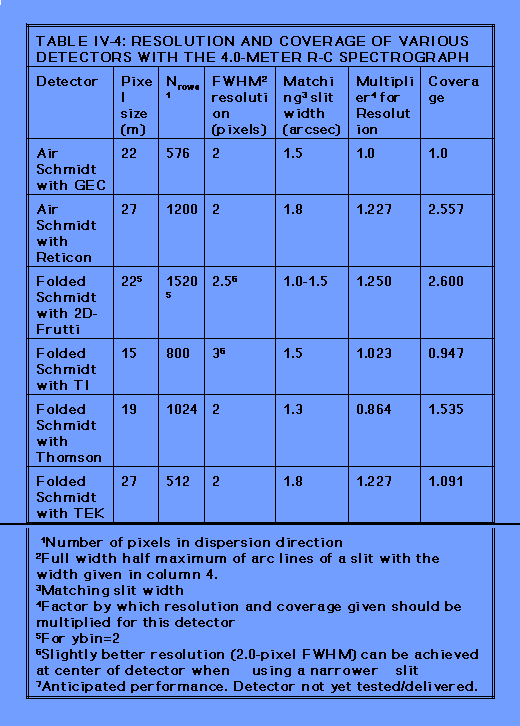4m RC Basic Optical Characteristics
THE 4.0-METER TELESCOPE
RITCHEY-CHRETIEN SPECTROGRAPH
a) Introduction
The R-C grating spectrograph is used at the f/7.8 R-C focus of the 4.0-meter telescope where the scale is 6.56 arcsec/mm. It is identical to the one at Kitt Peak National Observatory, in construction and as far as possible, in operation. The distinguishing feature of these 4.0-meter spectrographs is their large beam size. As a result, higher dispersion than usual for Cassegrain spectrographs is available, along with excellent spatial resolution for observations of extended objects. All functions of the spectrograph can be controlled remotely by the data acquisition computer, permitting convenient and efficient operation.
b) Acquisition and guiding
In normal operation, slit viewing is accomplished by means of a TV mounted on the instrument rotator. Two positions of the instrument rotator mirror carriage provide for direct viewing of the field, for target acquisition and for viewing light reflected from the spectrograph slit. The field of view in slit viewing mode is somewhat restricted, so that only the central arc minute of the spectrograph slit is visible on the TV. Auto guiding is normally accomplished using a separate TV camera, optically coupled to the offset guide probe, mounted in the instrument rotator, in conjunction with a leaky guider module. It is also possible to connect the same leaky guider to the slit viewing TV in order to permit auto guiding on light reflected from the slit jaws. Full details of the acquisition TV system and auto-guiders can be found in Section III. The spectrograph itself has both front-slit and rear-slit viewing optics.
c) Spectrograph rotation
The spectrograph may be rotated by up to 180 under remote control from the console room, with the telescope in any position. Observer support personnel should be notified of your intention to do so at the start of your run so that they can ensure that all cables have been routed to permit this. Normally the spectrograph is mounted with the slit E-W (PA=90 ).
d) Optical layout
The optical diagram for the spectrograph is given in Figure IV-1. The following descriptive sections are listed in the order which light passes through the spectrograph.
e) Decker
The decker plate for defining the length of the slit has five stellar/comparison pairs, a pointer for marking the center of the slit, a position for holding a calibration wedge, and a fully open position. The relevant dimensions are listed in Table IV-1.
f) Slit
The entrance slit has a length of 50 mm. Its width has a range from closure to 50 mm. One second of arc corresponds to approximately 150 microns. The size of the slit projected on the detector can be calculated from the information given in Figure IV-2. The conventional slit can be replaced by an aperture plate, permitting the acquisition of spectra of several objects distributed over an approximately 5 arcmin diameter field. Aperture plates are currently prepared in advance at NOAO Tucson. A TV camera can be attached to the rear-slit viewing periscope to assist in registering the apertures with the program objects. Observers with a potential interest in this system should contact CTIO staff well in advance of their run.
g) Multiple aperture plate
The multiple aperture plate contains 55 holes each 150 wide (1 arcsec) at 1.0 mm (6.6 arcsec) intervals along the slit. Exposures of the quartz lamp or white spot taken through these multi-holes are used to calibrate the geometric distortions introduced by the detector/camera combination for long slit work.
h) Filters
Two filter bolts are available each containing four filters plus a clear position. The lower filter bolt always contains neutral density filters; the upper-filter bolt either contains further neutral density filters or order sorting filters. An additional holder to contain a single order sorting filter can be manually placed in the beam if required. Note that this can only be done with the image tubes turned off if the 2D-Frutti is in use. Since all these filters are below the slit, the appropriate filters should be in place when the spectro- graph is focussed. The available filters are listed in Table IV-2.
i) Shutter-Newall mask
A four-position plate acts as a shutter and Newall mask. The positions are: open, closed, mask north half and mask south half. The latter two are used for quantitative focusing of the spectrograph. Successive exposures of a comparison source are taken through each mask. At perfect focus, the positions of the arc lines in these exposures coincide exactly. Increasing departures from focus lead to greater displacements between the images. An additional high speed computer controlled shutter is used to obtain precisely timed exposures.
j) Collimator
The collimator mirror is an off-axis paraboloid of 225 mm diameter and 1161 mm focal length. The point-source beam size is 152 mm. The collimator has a travel of 38.1 mm for focusing the image of the slit onto the detector.
k) Gratings
At present, there are thirteen 203 by 254 mm gratings available. Their nominal specifications are listed in the Table IV-3. Table IV-4 lists the resolution and coverage available with various detectors. Tables IV- 5, IV-6, and IV-7 list grating efficiencies.
l) Cameras
Two Air Schmidt cameras are available. The Air Schmidt camera is a field-flattened Schmidt camera of 229 mm focal length and 229 mm clear aperture. This camera is exclusively used with a CCD detector, which together with its special dewar, forms an integral part of the camera. All optical surfaces of the "red" Air Schmidt are coated to give optimal performance in the red and as a result, this camera cannot be used blueward of 4500 , the "blue" Air Schmidt can be used at all optical wavelengths (3000 - 10000 ) but is less efficient that the "red" Air Schmidt redward of 5000 .
The Folded Schmidt camera is also a field-flattened Schmidt camera with 229 mm focal length and optical characteristics almost identical to the Air Schmidt. The corrector is optimized for blue and near UV wavelengths. The incorporation of a folding flat in the optical train brings the focal plane outside the body of the camera, permitting its use with the 2D-Frutti photon counting system or the CCDs mounted in standard "direct" dewars. This causes the camera to have somewhat less clear aperture and consequently greater vignetting than the Air Schmidt. On-axis, the Folded Schmidt has nearly the same throughput as the Air Schmidt. For distances of greater than 10 mm off-axis, the through-put begins to fall off significantly. The uv transmitting optics provide for excellent throughput at wavelengths all the way down to the atmospheric cutoff.
m) Calibration sources
Two calibration sources, Th-Ar and He-Ne-Ar, are mounted in the instrument rotator. It is possible to turn on the He-Ar and the Ne lamps separately. A quartz continuum lamp for flat-field calibration is also available. With a manually operated filter bolt in the rotator, it is possible to attenuate the comparison source light by a factor of either three or ten. A lens is moved over the slit of the spectrograph to provide an f/7.6 beam for comparison exposures.
Updated on June 9, 2021, 8:36 am



